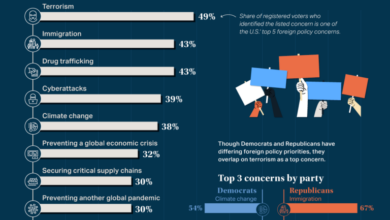
Hard Right Populists Are Pushing Into The Mainstream
Hard right populists are pushing their way into the mainstream, and it’s a development that’s shaking up the political landscape worldwide. From the subtle shifts in established party platforms to the increasingly vocal presence of extremist voices in public discourse, the influence of hard-right populism is undeniable. This isn’t just about fringe movements anymore; we’re seeing a realignment of power, a reshaping of the political conversation, and a profound impact on the very fabric of our societies.
Understanding this phenomenon is crucial to navigating the complexities of the modern political world.
This growing influence isn’t happening in a vacuum. Socio-economic anxieties, coupled with the rise of social media and the erosion of trust in traditional institutions, have created fertile ground for hard-right populist movements to take root and flourish. We’ll explore the historical context, analyze their messaging strategies, and delve into the potential consequences of this seismic shift in global politics.
Rise of Hard Right Populist Movements: Hard Right Populists Are Pushing Their Way Into The Mainstream

The rise of hard-right populist movements is a complex phenomenon with deep roots in socio-economic anxieties and political dissatisfaction. These movements often capitalize on feelings of alienation and disenfranchisement, promising radical solutions to perceived problems and tapping into a potent blend of nationalism, anti-establishment sentiment, and cultural conservatism. Understanding their historical precedents and current manifestations is crucial to analyzing their impact on global politics.
Historical Examples of Hard Right Populist Movements
Three significant historical examples illustrate the rise and impact of hard-right populism. These movements, while distinct in their specific contexts, share common threads of anti-establishment rhetoric, appeals to national identity, and the scapegoating of minority groups or external forces.
- The Nazi Party in Germany (1920s-1945): Exploiting post-World War I economic hardship and national humiliation, the Nazi Party rose to power through a potent mix of ultranationalism, antisemitism, and promises of restoring German greatness. Their propaganda effectively targeted anxieties about economic instability and social change, leading to their electoral success and the establishment of a totalitarian regime.
- Italian Fascism under Mussolini (1922-1943): Mussolini’s Fascist Party gained power in Italy by exploiting similar anxieties following World War I. Their emphasis on national rejuvenation, order, and strong leadership resonated with a population weary of political instability and economic woes. The party utilized aggressive propaganda and suppression of dissent to consolidate its power.
- The McCarthy Era in the United States (1950s): While not a strictly political party, Senator Joseph McCarthy’s anti-communist crusade exemplifies hard-right populism’s appeal to fear and suspicion. His tactics of public accusations and character assassination, often without evidence, resonated with anxieties about the Cold War and communist infiltration, creating a climate of fear and intolerance.
Current Hard Right Populist Movements
Hard-right populism continues to manifest in various forms across the globe, reflecting unique national contexts and socio-economic conditions.
- The rise of Hindu nationalism in India under the Bharatiya Janata Party (BJP): The BJP, led by Narendra Modi, has harnessed Hindu nationalist sentiment to achieve significant electoral success. Their policies often prioritize Hindu interests, leading to concerns about religious minorities and secularism.
- The success of right-wing populist parties in Europe: Parties like the National Rally in France (formerly the National Front) and the Alternative for Germany (AfD) have gained considerable traction by exploiting anxieties about immigration, globalization, and the European Union. Their platforms often emphasize national sovereignty and cultural preservation.
- The emergence of hard-right movements in Latin America: Several Latin American countries have witnessed the rise of right-wing populist leaders who often appeal to anti-establishment sentiment and promises of law and order, sometimes accompanied by authoritarian tendencies.
Socio-Economic Factors Contributing to the Rise of Hard Right Populism
Several interconnected socio-economic factors contribute to the rise of hard-right populist movements.
Economic inequality and stagnation often fuel resentment and a sense of disenfranchisement, creating fertile ground for populist appeals promising radical solutions. Globalization and technological advancements have led to job losses and economic insecurity in many communities, fostering anxieties about the future. Immigration, often framed as a threat to national identity and resources, becomes a key target for hard-right populist rhetoric.
Finally, a decline in trust in traditional institutions, including political parties and the media, creates a vacuum that populist leaders readily fill.
Timeline: The Rise of the BJP in India
The BJP’s rise to prominence is a complex process spanning decades.
This timeline focuses on key milestones:
| Year | Event |
|---|---|
| 1980s | The BJP emerges as a significant player in Indian politics, capitalizing on Hindu nationalist sentiment. |
| 1990s | The demolition of the Babri Masjid in Ayodhya sparks widespread communal violence, further fueling Hindu nationalist fervor and boosting the BJP’s popularity. |
| 2000s | The BJP experiences periods of both power and opposition, gradually consolidating its base and refining its political strategy. |
| 2014 | Narendra Modi becomes Prime Minister, marking a watershed moment in the BJP’s ascendancy. |
| 2019 | The BJP wins a landslide victory in the general elections, solidifying its dominance in Indian politics. |
Hard Right Populist Rhetoric and Messaging

Hard right populist movements across the globe share a common thread: a carefully crafted rhetorical strategy designed to resonate with specific anxieties and aspirations within their target demographics. This messaging transcends national borders, adapting to local contexts while retaining a core set of themes and techniques. Understanding these techniques is crucial to analyzing the rise and impact of these movements.The effectiveness of hard right populist rhetoric lies in its simplicity, emotional appeal, and use of powerful imagery.
It often bypasses complex policy debates, focusing instead on direct emotional appeals to fear, anger, and resentment. This approach allows for a broad appeal, uniting diverse groups under a shared sense of grievance against perceived enemies.
Common Rhetorical Strategies
Hard right populist leaders frequently employ several key rhetorical strategies. These include the use of “us vs. them” narratives, simplistic solutions to complex problems, the demonization of opponents, and the cultivation of a strong, charismatic leader figure who embodies the will of the people. They frequently exploit existing societal divisions based on ethnicity, religion, or class, framing these divisions as fundamental conflicts requiring decisive action.
The language used is often blunt, assertive, and unapologetic, aiming to project strength and decisiveness.
Language and Imagery
The language used by hard right populists is characterized by its directness and emotional intensity. Terms like “invasion,” “globalist,” “elite,” and “traitor” are commonly used to dehumanize opponents and stoke fear among their supporters. Imagery frequently evokes a nostalgic past, contrasting it with a perceived decline in national strength and moral values. This often includes visual representations of national symbols, flags, and historical figures, used to evoke a sense of patriotism and national pride.
For example, the use of strong nationalistic imagery in rallies and online propaganda creates a sense of unity and shared identity among supporters.
Cross-National Comparisons
While the specific issues and targets vary across countries, the core messaging of hard right populists shows remarkable consistency. In the United States, the focus might be on immigration and “cultural wars,” while in Europe, concerns about the European Union and national identity often take center stage. However, the underlying rhetorical strategies – the use of simplistic narratives, the demonization of opponents, and the appeal to a sense of national victimhood – remain remarkably similar.
This commonality suggests a broader underlying appeal that transcends specific national contexts.
Examples of Hard Right Populist Slogans and Propaganda, Hard right populists are pushing their way into the mainstream
The following examples illustrate the common themes and rhetorical strategies employed:
- “Make America Great Again” (USA)
– Appeals to nostalgia and a perceived past glory. - “Take Back Our Country” (Various countries)
– Frames the political struggle as a fight for national reclamation. - “Stop the Invasion” (Various countries)
– Uses inflammatory language to depict immigration as a threat. - “The People vs. The Elite” (Various countries)
– Creates an “us vs. them” dichotomy. - Images of strong leaders alongside national flags or symbols – Evokes patriotism and national unity.
The rise of hard-right populism isn’t just a fleeting trend; it’s a powerful force reshaping the political landscape. Understanding the strategies, motivations, and potential consequences of this movement is crucial for engaging in informed political discourse and safeguarding democratic institutions. While the future remains uncertain, one thing is clear: the mainstreaming of these ideologies presents significant challenges and requires careful consideration of their impact on society, international relations, and the future of democracy itself.
The conversation, and the fight for the future, is far from over.
It’s a crazy time, right? Hard-right populists are pushing their way into the mainstream, making me question everything. It feels like we’re hurtling towards some unknown future, almost as mind-boggling as the question of whether, as I read on this fascinating article, could life exist on one of Jupiter’s moons. The sheer scale of that possibility makes the current political climate seem almost…
manageable, in a strange way. But then I remember the populists, and the unease returns.
It’s a crazy time, with hard-right populists seemingly gaining traction everywhere. I find myself wondering if focusing on longevity strategies, like exploring whether can fasting help you live to 100 , might be a better use of my energy than fighting the tide. Of course, ignoring the rise of extremism isn’t an option, but sometimes a healthy lifestyle feels like the only thing I can truly control in this increasingly chaotic world.
It’s unsettling how hard-right populists are pushing their way into the mainstream, twisting narratives to suit their agendas. This feels especially relevant when you consider the seemingly idyllic world portrayed online; for example, check out this article about how british farms are luring the Instagram crowd , a seemingly harmless trend that could easily be manipulated by those same populists to promote a romanticized, outdated vision of rural life and traditional values.
Ultimately, this highlights how even seemingly innocuous trends can be exploited to further divisive political aims.





